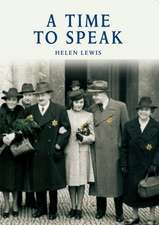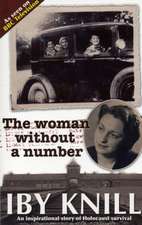The Emergence of Jewish Ghettos during the Holocaust
Autor Dan Michman Traducere de Lenn J. Schrammen Limba Engleză Paperback – 20 aug 2014
| Toate formatele și edițiile | Preț | Express |
|---|---|---|
| Paperback (1) | 175.70 lei 6-8 săpt. | |
| Cambridge University Press – 20 aug 2014 | 175.70 lei 6-8 săpt. | |
| Hardback (1) | 688.03 lei 6-8 săpt. | |
| Cambridge University Press – 30 ian 2011 | 688.03 lei 6-8 săpt. |
Preț: 175.70 lei
Nou
Puncte Express: 264
Preț estimativ în valută:
33.62€ • 34.74$ • 27.98£
33.62€ • 34.74$ • 27.98£
Carte tipărită la comandă
Livrare economică 26 martie-09 aprilie
Preluare comenzi: 021 569.72.76
Specificații
ISBN-13: 9781107437128
ISBN-10: 1107437121
Pagini: 200
Ilustrații: 9 b/w illus. 10 maps
Dimensiuni: 152 x 229 x 12 mm
Greutate: 0.3 kg
Editura: Cambridge University Press
Colecția Cambridge University Press
Locul publicării:New York, United States
ISBN-10: 1107437121
Pagini: 200
Ilustrații: 9 b/w illus. 10 maps
Dimensiuni: 152 x 229 x 12 mm
Greutate: 0.3 kg
Editura: Cambridge University Press
Colecția Cambridge University Press
Locul publicării:New York, United States
Cuprins
Introduction; 1. Historiography and popular understandings; 2. 'Ghetto': the source of the term and the phenomenon in the early modern era; 3. 'Ghetto' and 'ghettoization' as cultural concepts in the modern age; 4. The Nazis' anti-Jewish policy in the 1930s and the question of Jewish residential districts; 5. First references to the term 'ghetto' in the discourse of the makers of anti-Jewish policies in the Third Reich (1933–8); 6. The semantic turning point in the meaning of 'ghetto': Peter-Heinz Seraphim and Das Judentum in osteuropäischen Raum (1938); 7. The invasion of Poland and the emergence of the 'classic' ghettos; 8. Methodological interlude: the term 'ghettoization' and its use during the Holocaust itself and later scholarship; 9. Would the idea spread to other places? Amsterdam 1941, the only attempt to establish a ghetto west of Poland; 10. Ghettos during the final solution, 1941–3: the territories occupied in Operation Barbarossa; 11. Ghettos during the final solution outside the occupied Soviet Union: Poland, Theresienstadt, Amsterdam, Transnistria, Salonika and Hungary; Summary and conclusion.
Recenzii
“This profound, insightful, and surprising book proves the extraordinary value of asking the right questions. Michman’s reassessment of the ghettos unsettles key assumptions about the Holocaust: about the role of antisemitism; links between ghettoization and mass murder; differences across Europe; and relations between the German leadership and the people who implemented anti-Jewish measures on the ground. Ghettos, Michman shows, were enormously significant, but they were neither uniform nor an inevitable step toward annihilation. Everyone interested in the Shoah, how it occurred, and how it has been understood, should read this book.” —Doris L. Bergen, University of Toronto
“Within a tight compass and with startling clarity, Dan Michman succeeds in shattering one misconception after another about the ‘ghettos’. They were not a uniform phenomenon and were not a prequel to the genocide. They were not even necessary for it. Yet, he shows how they were rooted in traditional anti-semitism and, especially, the German phobia towards East European Jews. His forensic analysis of how the concept evolved and how it was applied in increasingly violent situations will compel every student and scholar to think twice before using the term. From here on, the standard histories will have to be re-written.” —David Cesarani, Royal Holloway, University of London
“By writing the first comprehensive study on the emergence and character of the ghetto phenomenon in the Third Reich, Dan Michman revises some key notions about the Holocaust. Going beyond an administrative and organizational history of the ghetto, Michman offers an erudite and sophisticated analysis of the semantic, linguistic, and cultural contexts of the term ghetto and its actual use in Nazi policy. The value of this approach is evident. By probing into where and when the idea originated among the Nazis and why its application was so uneven and complex, he opens new questions about the persecution and extermination of the Jews.” —Alon Confino, University of Virginia
“Dan Michman’s investigation of the emergence and evolution of the idea of the ghetto among Nazi policymakers is a masterpiece of historical detective work that convincingly undermines decades-old assumptions. Among other things, it shows how Nazi Jewish policy unfolded in at least some measure in response to anticipated behavior by Jews. The most experienced scholars of the Holocaust will find much new in this work.” —David Engel, New York University
“Dan Michman casts a great deal of new light on the emergence and function of the ghettos: on the pre-history of ghettos, the different applications of the term, and the variety of concepts of ghetto that developed in the Third Reich. This is an important contribution, which only someone with Michman’s linguistic gifts could have accomplished.” —Ian Kershaw, University of Sheffield
"...Dan Michman’s analysis, based on very close reading of key documents, is a powerful challenge from a formidable historian for scholars to rethink long-held assumptions regarding the place of ghettoization in Nazi thinking and policy." -Norman J. W. Goda, The Journal of Modern History
“Within a tight compass and with startling clarity, Dan Michman succeeds in shattering one misconception after another about the ‘ghettos’. They were not a uniform phenomenon and were not a prequel to the genocide. They were not even necessary for it. Yet, he shows how they were rooted in traditional anti-semitism and, especially, the German phobia towards East European Jews. His forensic analysis of how the concept evolved and how it was applied in increasingly violent situations will compel every student and scholar to think twice before using the term. From here on, the standard histories will have to be re-written.” —David Cesarani, Royal Holloway, University of London
“By writing the first comprehensive study on the emergence and character of the ghetto phenomenon in the Third Reich, Dan Michman revises some key notions about the Holocaust. Going beyond an administrative and organizational history of the ghetto, Michman offers an erudite and sophisticated analysis of the semantic, linguistic, and cultural contexts of the term ghetto and its actual use in Nazi policy. The value of this approach is evident. By probing into where and when the idea originated among the Nazis and why its application was so uneven and complex, he opens new questions about the persecution and extermination of the Jews.” —Alon Confino, University of Virginia
“Dan Michman’s investigation of the emergence and evolution of the idea of the ghetto among Nazi policymakers is a masterpiece of historical detective work that convincingly undermines decades-old assumptions. Among other things, it shows how Nazi Jewish policy unfolded in at least some measure in response to anticipated behavior by Jews. The most experienced scholars of the Holocaust will find much new in this work.” —David Engel, New York University
“Dan Michman casts a great deal of new light on the emergence and function of the ghettos: on the pre-history of ghettos, the different applications of the term, and the variety of concepts of ghetto that developed in the Third Reich. This is an important contribution, which only someone with Michman’s linguistic gifts could have accomplished.” —Ian Kershaw, University of Sheffield
"...Dan Michman’s analysis, based on very close reading of key documents, is a powerful challenge from a formidable historian for scholars to rethink long-held assumptions regarding the place of ghettoization in Nazi thinking and policy." -Norman J. W. Goda, The Journal of Modern History
Notă biografică
Descriere
This is a linguistic-cultural study of the emergence of Jewish ghettos during the Holocaust.














